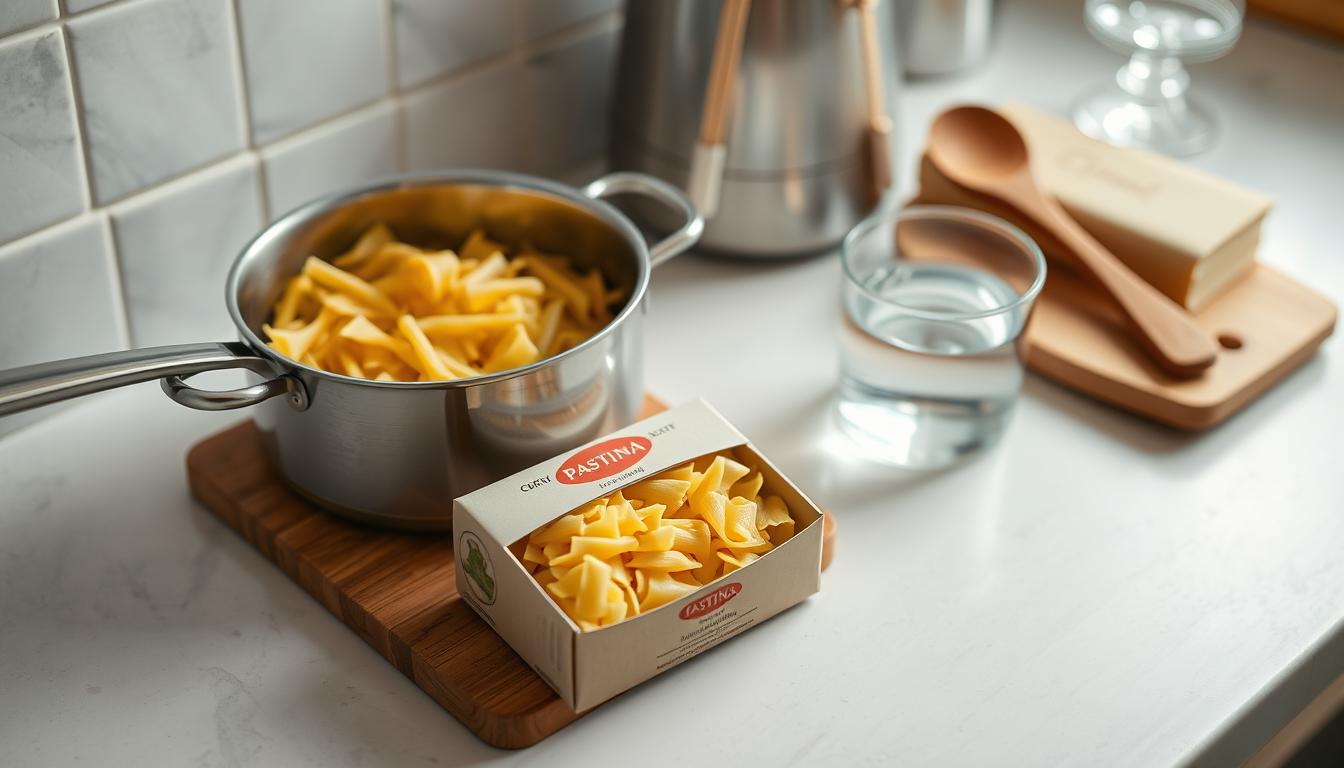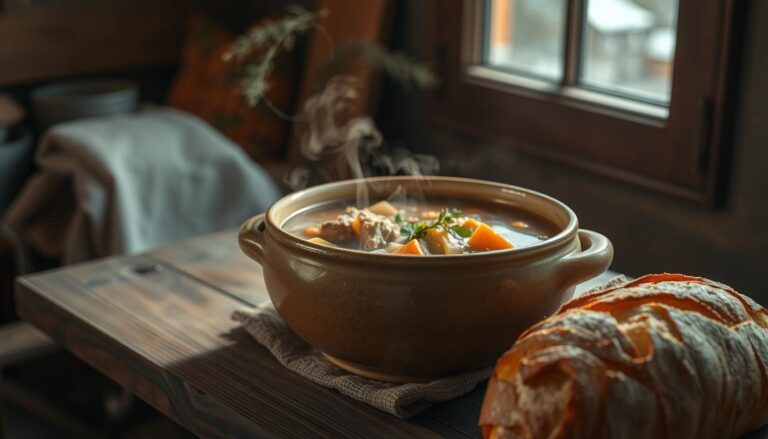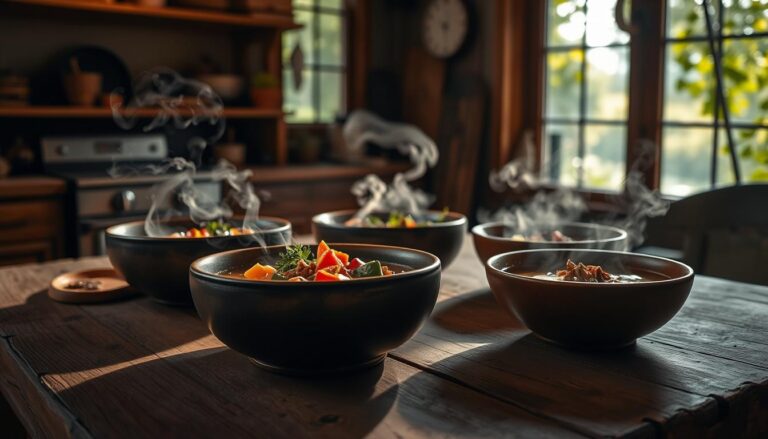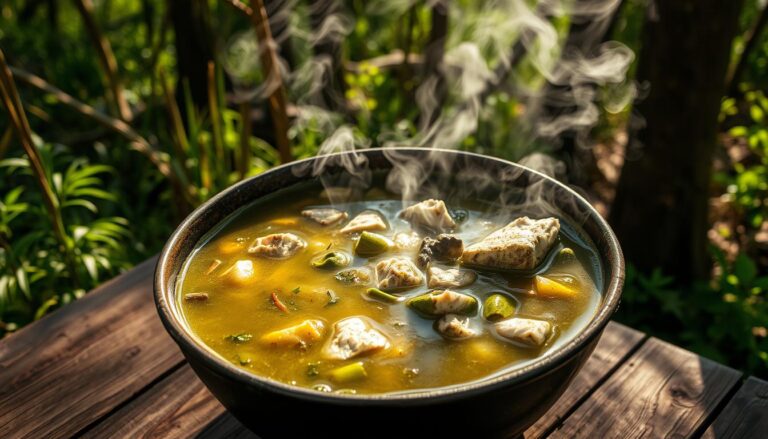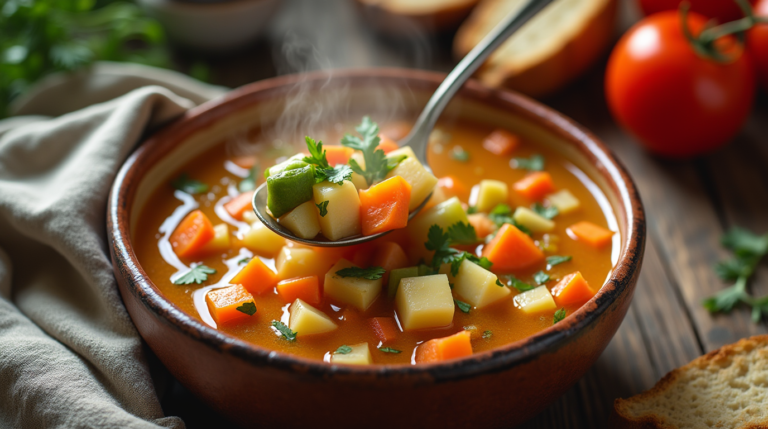A simple bowl of pastina can warm up a room. The steam rises, and herbs brighten each spoonful. It’s more than a meal; it connects us to our family’s kitchen traditions. So, let’s Master the Art of Making Pastina, the Classic Italian Staple
Pastina’s ingredients are simple: tiny pasta, rich broth, and herbs. Yet, they hold a deep flavor that’s hard to resist. It’s often the first dish people learn to cook, opening the door to Italy’s culinary heart.
Making pastina isn’t complicated. It’s about following a simple process. Simmer vegetables in broth until they’re fragrant, then stir in pasta until it’s just right. Each step brings you closer to a dish that feels like a warm hug.
Table of Contents
Introduction to Pastina: A Timeless Italian Classic
Imagine a warm bowl of pastina recipe, loved for ages in Italian homes. This small pasta is more than comfort food; it’s a family treasure. It started in rural Italy, where its simplicity holds deep cultural value. Its name, “little pasta,” shows its humble start and its role in nourishing families.
Pastina is the pasta that warms the soul, blending tradition with modern creativity.
Origins and Cultural Roots
Pastina has its roots in the 18th century, in Emilia-Romagna. Its small size cooks fast, ideal for quick meals. It was a favorite for kids and those needing easy-to-digest food. Now, it connects families across generations.
Why You Should Try to Master the Art of Making Pastina, the Classic Italian Staple Today
With a pastina recipe ready in 25 minutes, it’s perfect for today’s fast pace. Here’s why it’s great:
- Quick and nourishing: Ready in under 30 minutes, packed with carbs for energy and protein from Parmigiano.
- Budget-friendly: Costs less than $5 per serving, using pantry staples like onion and broth.
- Versatile: Swap broth for tomato sauce or add chili for a spicy twist, making it adaptable to any taste.
Its creamy texture and rich history make it more than food; it’s a link to Italian culture. Whether for a cozy dinner or new flavors, pastina recipe brings tradition and modern flair.
Understanding the History and Origins of Pastina
Pastina’s story starts in Italy’s kitchens. Small pasta shapes became key in soups and comfort foods. For centuries, people made homemade pastina from flour and water. Its history goes back to the 12th century, shaped by regional traditions.
| Type | Shape | Region | Traditional Use |
|---|---|---|---|
| Orzo/Risoni | Rice-like grains | Tuscany | Soups, stews, and salads |
| Acini di Pepe | Peppercorn spheres | Liguria | Broths and creamy sauces |
| Fregola | Small beads | Sardinia | Tomato-based soups, seafood dishes |
Many varieties reflect Italy’s history. Names like abissini or tripolini hint at colonial ties. Others, like grattini, show hand-made origins. These shapes connect past and present.
Today, homemade pastina recipes live on in family kitchens. Tradition meets innovation here. Pastina’s journey from medieval Italy to today’s tables shows food’s power to preserve heritage and adapt to new tastes. Every bite tells stories of resilience and love passed down through generations.
Gathering Ingredients for the Best Pastina Recipe
The key to a great easy pastina recipe is starting with the right ingredients. Choose high-quality pasta like Barilla Pastina for the perfect tiny stars. Fresh Parmigiano-Reggiano from Italy adds a rich flavor, while real Italian olive oil boosts the taste. Here’s how to pick each part:
“A dish is only as good as its ingredients,” says Rome-based chef Marco Conti.
Key Ingredients Checklist:
- Pastina: Opt for Barilla or De Cecco brands for consistent texture.
- Parmigiano-Reggiano: Look for PDO-certified wheels from Parma or Reggio Emilia.
- Stock: Use homemade chicken or vegetable broth for richer flavor.
- Seasonings: Fresh garlic, black pepper, and nutmeg for authentic depth.
Optional Enhancements:
- Finely chopped parsley for garnish.
- Unsalted butter for creaminess.
- Parmesan rinds to simmer in broth for umami depth.
Nutrition at a Glance:
| Calories | 181 kcal |
|---|---|
| Carbs | 38g |
| Protein | 6g |
| Key Minerals | Calcium 29mg, Iron 1mg |
Choose quality vegetables like carrots and onions from local farms. Always check the expiration dates on dairy products. For an easy pastina recipe, focus on freshness over exotic ingredients. Keep essentials like tomato paste and bouillon cubes on hand for quick broth bases. The right ingredients make cooking a true Italian tradition.
Step-by-Step Guide: How to Make Pastina
First, heat 2 cups of broth or water in a saucepan. Bring it to a boil over medium-high heat. Pro tip: Grass-fed bone broth adds depth, but water works perfectly if preferred.
- Pour in ½ cup pastina. Stir gently to prevent clumping.
- Cook uncovered for 4-5 minutes, stirring occasionally. The pasta should absorb liquid and become tender.
- Remove from heat. Add 1 tbsp butter and 6 tbsp warm milk. Stir until melted and smooth.
- Season with salt, pepper, or a squeeze of lemon. Optional: Fold in ¼ cup grated Parmesan or nutritional yeast for creaminess.
For substitutions: Use gluten-free pasta or orzo if pastina isn’t available. Dairy-free options include avocado oil and nutritional yeast. Add herbs like parsley or protein like diced chicken for extra nutrition.
Storage: Cool completely, then refrigerate in an airtight container up to 3 days. Reheat with a splash of milk to restore creaminess.
- Calories per serving: 366
- Protein-rich with 20g per batch
- Adjust seasoning to taste preferences
Cook pastina as a comforting base for soups, stews, or standalone side dish. Experiment with toppings like crispy bacon bits or sautéed mushrooms for variation.
Tips for Achieving Creamy and Delicious Pastina
Making the best pastina recipe needs careful steps. Follow these tips to avoid mistakes and boost flavor. Cook pastina in broth for exactly 2 minutes to keep it tender but firm. Stir constantly and taste often to prevent mushiness.
Avoiding Overcooking
Cook pastina in simmering broth until it’s al dente. Stir right after adding pasta to avoid clumps. Remove from heat when the pasta is tender but still slightly firm at the center. Let it rest for 30 seconds to absorb liquid without overcooking.
Using the Right Dairy and Seasonings
For creaminess, melt butter and freshly grated Parmesan or Pecorino Romano into the pasta after cooking. Add cream or milk if it’s too dry. Season with black pepper and a squeeze of lemon juice to balance richness. Use freshly grated cheese for better melting.
- Use unsalted butter to control saltiness
- Stir in herbs like parsley or basil after cooking for brightness
- Add a pinch of nutmeg for depth
Drizzle with olive oil and sprinkle with lemon zest before serving. Taste before final seasoning, as cheese and broth add natural salt. Serve immediately to keep it creamy.
Traditional Pastina Recipe Vs. Easy Pastina Recipe
When making creamy pastina, you have two paths: the classic method or a streamlined version. Traditional recipes simmer pastina in broth with aromatics like onion and carrot, creating a hearty ragout. The easy version skips slow cooking, using store-bought broth and quick prep for a 20-minute meal.

“The essence of pastina lies in balance—whether you choose tradition or convenience,” says Rome-based chef Marco Rossi. Both methods start with 1 cup of pastina cooked in 2 cups of liquid, but texture differs. The classic method achieves a richer, silkier mouthfeel by reducing broth slowly. The simplified version achieves creaminess faster by mixing butter and Parmesan immediately after cooking.
- Traditional: Simmers vegetables, broth, and pasta for 15-20 minutes
- Easy: Whisk butter and cheese into al dente pasta post-boil
Both versions deliver 200-307 calories per serving. The classic method uses parmesan rind for depth, while the easy option swaps in grated cheese. Meal preppers love the simplified approach—cook pasta separately, store broth, and reheat with fresh dairy. For family dinners, the traditional method shines with added vegetables or protein. Choose based on time: creamy pastina can be ready in 15 minutes or elevated into a 30-minute meal.
Innovative Approaches to Traditional Pastina Recipe
Make the traditional pastina recipe exciting with new twists. Keep the classic feel but add fresh tastes. It’s all about trying new things while staying true to the original.
Modern Ingredient Twists
Try new ingredients to change up the dish. Dan Pelosi’s Pastina for One recipe is a great start. It adds spinach or turkey for more protein. Here are some other ingredients to swap in:
| Traditional Element | Modern Twist |
|---|---|
| Plain broth | Roasted garlic-infused broth |
| Plain pasta | Whole-grain pastina for fiber |
| Simple herbs | Smoked paprika or chili flakes |
Try pairing pastina with sautéed shrimp or avocado. It makes for a light yet satisfying meal.
Fusion Cooking Ideas
Blend different flavors into your dish:
- Add soy sauce and sesame oil for an Asian twist
- Toss with taco seasoning and black beans for a Tex-Mex flavor
- Layer with pesto and pine nuts for an Italian-Mediterranean mix
For a data-driven approach, here’s the nutrition breakdown of Dan Pelosi’s recipe:
| Nutrient | Amount |
|---|---|
| Calories | 300 kcal |
| Protein | 13g |
| Carbs | 51g |
| Optional Additions | Spinach (4g fiber), 4g sugar) |
Experiment with textures and spices. This way, you can surprise your taste buds without losing the traditional charm.
Pairings and Sides to Elevate Your Pastina Meal
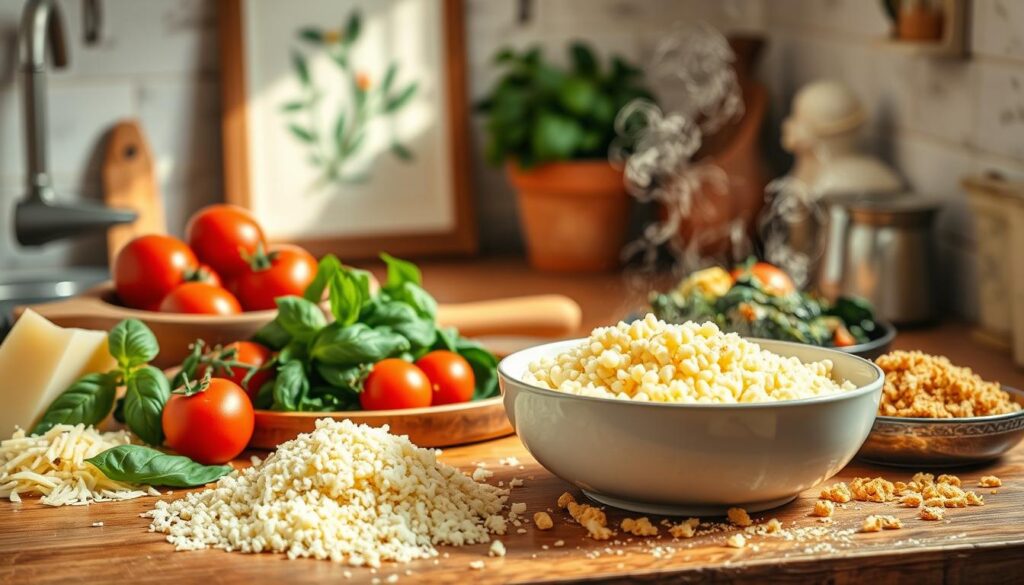
Pair your pastina dish with flavors that highlight its delicate taste. Start with protein-rich mains like roasted chicken or shrimp scampi to add depth. For vegetarian options, try grilled zucchini or a Mediterranean platter with marinated olives and artichokes.
- Seafood lovers: Combine pastina soup with baked salmon or garlic shrimp.
- Vegetarian choice: Toss pastina with roasted veggies and pine nuts for a grain bowl.
- Classic combo: Serve with crusty bread to soak up broth and a crisp side salad.
| Pairing Type | Examples |
|---|---|
| Grain Bowls | Orzo with avocado, sun-dried tomatoes, and basil pesto. |
| Warm Sides | Lemon Parmesan lettuce salad or garlic bread. |
| Appetizers | Hummus with pita and marinated veggies. |
For a modern twist, top pastina with creamy pesto and microgreens. Data shows roasted chicken or seafood pairs well with its mild flavor. Add crunch with toasted pine nuts or a crisp lettuce wedge. Always serve with a tangy dressing or fresh herb garnish to brighten the dish.
Balance textures and temperatures—try warm pastina alongside a chilled beet salad. Experiment with regional staples like Italian bruschetta or caprese skewers for a cohesive meal. Let the subtle pasta flavors take center stage while sides add contrasting elements.
Troubleshooting Common Mistakes When You Cook Pastina
Making pastina can go wrong if you overlook small details. Here’s how to fix common issues and get it right every time.
Preventing Starch Clumps
- Stir pasta constantly when adding broth to avoid sticking.
- Use a pot large enough to prevent overcrowding, which causes clumping.
- Rinse pasta under cold water before adding to sauces to reduce starch buildup.
Maintaining the Perfect Texture
Overcooked pastina turns mushy—avoid this by:
- Setting a timer for the recommended cook time (usually 3–5 minutes).
- Checking pasta frequently after 2 minutes to test for al dente firmness.
- Adding broth gradually while whisking eggs to avoid curdling.
Adjust broth slowly—start with 1 cup, adding ½ cup at a time until desired creaminess. If the soup is too thick, thin with warm broth. Too thin? Simmer uncovered to reduce liquid. Always taste test before serving to balance seasoning.
Essential Kitchen Tools and Techniques to Master the Art of Making Pastina, the Classic Italian Staple
Mastering pastina starts with the right tools and methods. Here’s how to equip your kitchen and refine your approach:
Proper Boiling Methods
- Use a Le Creuset Dutch Oven or large stainless steel pot for even heat.
- Boil water at 212°F (100°C) before adding pastina to prevent clumping.
- Stir gently every 2 minutes during the 6-minute cook time with a wooden spoon.
- Reserve 1 cup pasta water using a ladle before draining.
Temperature Control Tips
- Invest in a Thermopro TP03 thermometer for precise broth monitoring.
- Maintain a simmer between 180-190°F (82-88°C) when preparing broth base.
- Adjust heat immediately if water reaches boiling point during sauce mixing.
| Tool | Purpose |
|---|---|
| Mesh strainer | Draining pasta while retaining cooking liquid |
| Cast iron pot | Even heat retention during simmering |
| Wire whisk | Emulsifying cheese into sauce smoothly |
Pro chefs recommend starting with broth at room temperature before heating. Always test pasta doneness at 6 minutes—al dente pastina should remain slightly firm in center. For creamy texture, add cubed butter in 16 equal portions while stirring continuously.
Conclusion
Pastina may seem simple, but it’s full of depth. This Italhttps://www.veloxrecipes.com/easy-italian-chicken-soup-a-delicious-healthy-meal/ian dish is a mix of tradition and modern touches. It’s perfect for any time, whether it’s a quick weeknight meal or a fancy dinner.
Using top-notch ingredients like Parmigiano-Reggiano and fresh herbs makes it even better. It’s quick to prepare, taking under 10 minutes. This makes it a favorite across generations, from baby’s first foods to family dinners.
It’s also packed with nutrients, with 200-250 calories per serving. This shows that you can have a filling meal without it being complicated. If you need to avoid gluten or dairy, you can easily make substitutions like oat milk or buckwheat pasta.
Pastina is often called “Italian penicillin” because it’s so comforting. It’s a dish that has been loved for centuries. Feel free to add your own twist with ingredients like spinach or truffle oil, but remember the key is to simmer gently and use fresh cheese.
Share it with your loved ones, adjust it to fit your dietary needs, or enjoy it as a late-night snack. This humble pasta shows that you don’t need fancy ingredients to make great food. It’s all about care and tradition. Now, it’s your turn to make it your own. The pot is waiting, and the flavors are ready.

